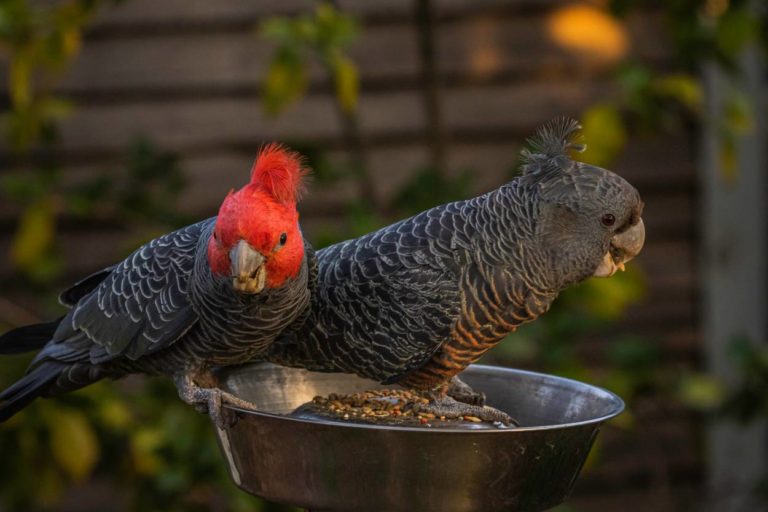
They were one of several mainland birds introduced to Kangaroo Island in South Australia between 19 when part of Flinders Chase was identified as a sanctuary due to its lack of pests. Until the 1960s, their habitat even stretched as far south as King Island, off Tasmania's northwest coast. They occur along the Great Dividing Range from the central north coast of NSW, through the ACT and central and southwestern Victoria, to the South Australian border," Taylor says.

"Gang-gangs are endemic to eastern Australia. While they hold a special spot in the heart of Canberrans, you'll also find gang-gangs well beyond the territory. "Some gang-gangs move to lower elevations in winter but some remain in areas with higher elevation," Taylor says. (The Southern brush-tailed rock-wallaby was chosen as the ACT's mammal emblem in 2018.) The gang-gang is also the insignia for the ACT Parks and Conservation Service and the Canberra Ornithologist Group-our local bird loving group. When the Australian Capital Territory adopted the gang-gang as its emblem in 1997 it was the only state or territory to feature a bird as its faunal emblem instead of a mammal. Many compare their call to the sound of a drawn-out creaky door." "Their most distinctive trait is their call that is often heard while they are in flight. If you can't get close enough to identify it, try listening instead. "They are not as commonly spotted as other similar sized parrots and should certainly not be mistaken for the much more common, but also beautifully colored, galah." "The males boast a spectacular red head and both the males and females have a wispy crest." "Gang-gangs are an incredibly beautiful parrot," Taylor says. Gang-gangs, one of 14 cockatoo species in Australia, are crowd favorites for their slate-gray feathers with blushes of pink, the male's distinctive red crest, and their quirky call. We asked our gang-gang guru what we know about the birds, what we still need to find out, and what makes these charismatic cockies special. No formal research or monitoring has been conducted about the species, says Stacey Taylor, a Master's student at The Australian National University (ANU) who is studying the patterns of occupancy of the gang-gang across the ACT. The call has been likened to a creaking gate or cork being pulled from a bottle.That became clear in this year's Bird of the Year poll, where they finished third out of 50 Australian native birds.ĭespite their popularity, we don't know a lot about them.

They range in length from 32 to 37 cm, with a wingspan of 62 to 76 cm. These birds are primarily slate-grey, with the males easily identified by their scarlet head and wispy crest, while females have a grey head and crest and feathers edged with salmon pink on the underbelly. Gang-gang cockatoos are one of the more distinctive and charismatic members of Australia’s avifauna. Loss of older, hollow-bearing trees and loss of feeding habitat across south-eastern Australia through land clearing has led to a significant reduction in the numbers of this cockatoo in recent years. Like all cockatoos, Gang-gangs nest in hollow trees.

It ranges throughout south-eastern Australia and Tasmania. The Gang-gang Cockatoo, Callocephalon fimbriatum, is found in the cooler and wetter forests and woodlands of Australia, particularly alpine bushland. Gangs also love to chew things and should be provided with stimulus to keep them interested and entertained (please refer to “ Foraging.” Gang Gangs are not considered to be a good pet bird due to their boredom related behavioural problems. Gang Gang Cockatoos form strong pair bonds with their owner and require a great deal of training and care to avoid the occurrence of behavioral problems.įeather picking as a result of boredom is a common condition seen in Gang Gangs that are deprived of the attention they require. They are usually seen in pairs, family parties or small groups, a social characteristic that makes this bird highly demanding as a pet. Sexing: Males have striking red heads, whilst that of the female is grey Number of Eggs: 2-3 eggs | Incubation: 23-25 daysĬompatibility with other species: Not recommendedįeeding: Seed and Fruit Eaters, especially the Oak and Casuarina nuts. Talking Ability: Good, with crackling voice | Noise Level: HighĬourtship Display: Male spreads wings, raises head and calls female to entrance of nest. In the wild, the Gang Gang Cockatoo is found along the eastern coast of Australia, inhabiting dense mountain forests and open woodland regions.


 0 kommentar(er)
0 kommentar(er)
